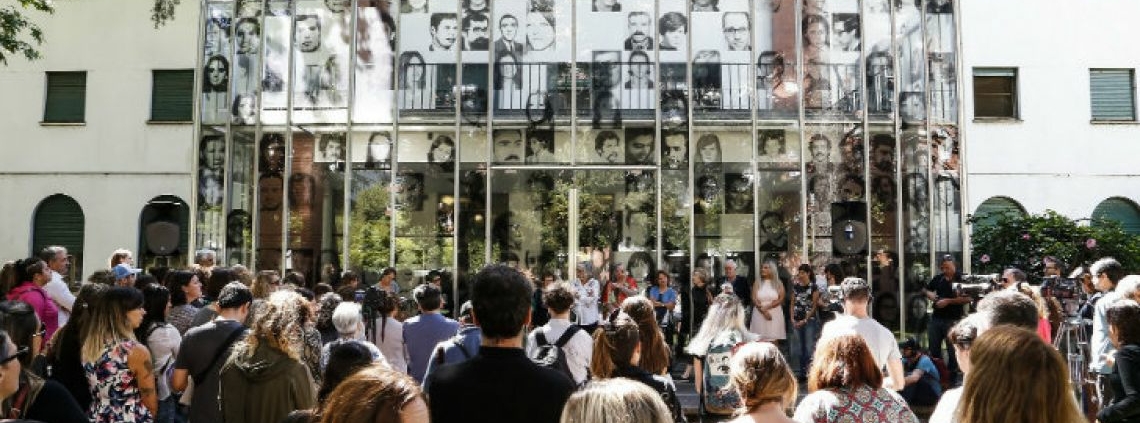The unheard stories of the women held inside ESMA
In a new exhibition, 28 women recall harrowing tales of rape and sexual abuse, carried out on detainees held at the former Navy Mechanics School during the military dictatorship. This is one woman’s tale.
It was the only the second time Graciela García Romero had entered the former Navy Mechanics School since her release in 1978. Her hands were sweating. She was nervous about returning to that infamous place, where she had been illegally held during the last military dictatorship (1976-1983). The memories kept flooding back.
Today, the site where Graciela was tortured, raped and abused is now a memorial. Today, she returned for the inauguration of a new exhibition detailing the sufferings experienced by women in the country’s most infamous clandestine detention centre, more commonly known as ESMA.
The exhibition, Ser Mujeres en la ESMA (“Being Women at ESMA”), retrieves her testimony and that of 27 other women who, like Graciela, suffered sexual violence while they were held captive.
Graciela only came forward in 2007 to report what had happened at ESMA, accompanied by lawyers Carolina Varsky and Pablo Llonto.
As Federal Judge Sergio Torres pointed out, when he indicted Jorge Eduardo Acosta in 2009 for his crimes, it took 30 years for her to build up the courage and dare to testify.
“When we were released, we were a bomb about to explode. Nobody wanted to get close,” said Graciela in an interview with the Times, a few days after the opening, at a café in Barrio Norte.
“We have to tell how badly those of us who were accused of being collaborators had it – and how being raped was associated with that.”
Graciela García Romero was kidnapped on October 15, 1976, in Buenos Aires City. After she was detained, she spent more than a month in the area called a “capucha”, lying on the floor with her head covered with a hood. Sometime later, she was moved to another space on the third floor.
It was there she came to learn the meaning of the phrase: “544, downstairs.” Every time a guard said it, she shrank inside. It meant one of the officers would come and rape a fellow detainee. ‘544’ was the identity that person had been ascribed within ESMA, dehumanising the prisoner and erasing their identity.
A memory returns to her as she talks. Once, she recalls, she was with three other female prisoners when a retired naval captain, Francis Whamond, appeared.
“Which personal care products do you want?” he asked the women.
“We looked at each other and thought he had gone mad,” Graciela recalls. “But [in fact] they were preparing us for them.”
How many of her comrades were raped? “I think that all the female prisoners who were held at ESMA in 1976 were raped. In that year they didn’t hide the crudity of the extermination,” she responds.
“The operation of the concentration camp changed in 1977, when the Montoneros’ finance arm was abducted. At that moment the repressors’ sexual drive was softened, and they focused on money. That’s what they effectively did: steal,” she said.
One day she was taken down to the office of Jorge “Tigre” Acosta, a Navy captain the head of the ESMA taskforce. There was little light in the room. He was wearing a light blue T-shirt and had a piece of cake in front of him, Graciela recalls.
“Do you want some?” he asked.
“Yes,” she answered. She was starving. For months she had eaten had sandwiches with rotten meat.
Acosta, who is now serving life in prison for numerous human rights crimes, spoke for several minutes. Eventually he said: “Well, tomorrow I’m going to get you out of here.”
Graciela knew what was coming. The next day she was taken to an apartment used by naval officers.
There they would rape them, use them, and later return them to the concentration camp. –
Shortly after she was abducted, Graciela was taken to a holiday home with other prisoners. Acosta and other naval officers were also there.
“Well, pick your couple,” ordered Captain Acosta.
Since none of them moved, he was the one who decided the pairings.
For Graciela, the sexual violence committed at the ESMA was planned. In their book on the subject, Putas y Guerrilleras, authors Miriam Lewin and Olga Wornat state that Captain Raúl Scheller, who died in 2015, told a US investigator that Acosta had ordered the officers to seize female prisoners.
“There is also something that has been left unsaid, namely what it meant to be gay in the clandestine centre,” adds Graciela. “I was one,” she adds.
After her release from ESMA in 1978, the repressors kept an eye on her. She was forced to work at the Foreign Affairs and Social Welfare Ministries, along with other prisoners.
“During that time, they took me twice to see Acosta. The last time I dared to tell him that I didn’t want to see him anymore,” she remembers. “I didn’t care if he killed me. To my surprise, Acosta told me that the same thing had been said to him by another comrade.”
“Be careful, Negrita, with women. They can hurt,” he told her.
“His words confirmed what I thought: he was tapping my communications,” she says today. “Acosta separated me a lot from the rest of the comrades. It’s obvious there must have been other gay comrades, but I didn’t see them. It must have been one more reason why they were killed.” –
In the years that have passed since those dark days, democracy did not heal the wounds of the survivors. Graciela lived with the stain of being a survivor, of having been picked to integrate a group within the ESMA (a small group of prisoners whom repressors labelled as ‘collaborators’), of having had a relationship with Acosta that she did not choose.
“I lived in isolation for a long time. A colleague told me to go to the Argentine Forensic Anthropology Team [EAAF in Spanish]. There a group was formed, and we used to meet on Wednesdays to make lists of people seen at ESMA. The next day, I was always sick.”
That’s how she met Carolina Varsky, a lawyer at the Centre for Legal and Social Studies (CELS). Varsky asked her if she wanted to sue Acosta.
“At the time the complaint was filed, sexual crimes were invisible,” says Varsky, currently the coordinator of the Attorney-General’s Crimes Against Humanity Office. “The survivors had referred to these offences before the National Commission on the Disappearance of Persons [Conadep in Spanish] and the courts during the Junta trial and the proceedings against Héctor Febres (2007), but nobody was investigating them.”
The challenge was, as Judge Torres explained, to separate sexual crimes from torture in order to make them visible and to demonstrate that it was also a systematic practice that sought to debase women.
Difficulties in prosecuting sex crimes continue. According to statistics from the office coordinated by Varsky, only 12 percent of the sentences condemned sexual abuse. Neither Acosta nor any other ESMA repressor has yet been convicted of these crimes. –
The exhibition about the women who were kidnapped in the ESMA was curated by journalist Alejandra Dandan. Its gathers sworn testimonies from 28 survivors about forced nudity, sexual violence and childbirth in the clandestine centre. Graciela’s is one of the testimonies making up the exhibition, which can be visited until June 14.
At ESMA, it is estimated that there were 5,000 illegal prisoners detained between 1976 and 1983. So far, investigators have found the names of 360 women held there and four baby-girls born in captivity.
“The script of the museum did not speak of women. We have taken care of that,” said Alejandra Naftal, the director of the museum, at its opening. “This exhibition is an appeal from the present to the past.”
https://www.batimes.com.ar/news/argentina/the-unheard-stories-of-the-women-held-inside-esma.phtml




